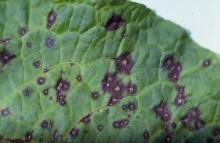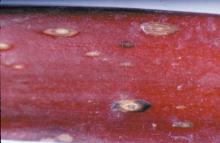Cause Ascochyta rhei and Ramularia rhei, fungi that overwinter on old rhubarb leaves and stalks. These fungi also can spread through infected rootstock. Leaf spots are common on field-grown rhubarb west of the Cascade Range due to frequent rains in March and April when leaves and stalks are actively growing. Both pathogens produce spores that move by wind and splashing water. Ramularia rhei may also spread by use of infected root stock.
Symptoms Ascochyta infections appear as small, yellow-green infections on the upper leaf surface. Later, spots merge to give a mosaic appearance. The spots' centers turn white and fall out, giving the leaf a tattered appearance.
Ramularia leaf spots first appear as a small red dot and increases up to a 1-cm whitish-tan circular area with a purplish halo. Lesions on stalks tend to be more elongated, rather than circular.
Cultural control
- Remove stalks with leaf spot symptoms at the beginning of harvest to reduce the source for new infections.
- After harvest, incorporate crop residues to reduce overwintering pathogen populations.
- Provide adequate fertility for plant growth in spring as well as regrowth after harvest to ensure strong, rapid plant growth.
- Plant pathogen-free rootstock; avoid propagating from diseased plants.
Chemical control
- Badge SC (Group M1) at 1 to 2.25 pints/A on 7- to 10-day intervals. Preharvest interval is 0 days. 48-hr reentry.
- Bravo WeatherStik (Group M5) at 3 pints/A on 7- to 10-day intervals. Do not apply within 30 days of harvest. 12-hr reentry.
- Cabrio EG (Group 11) at 12 to 16 oz/A on 7- to 14-day intervals. Do not make more than one (1) application of Cabrio EG or other Group 11 fungicide before alternating to a labeled fungicide with a different mode of action. Preharvest interval is 0 days. 12-hr reentry.
- Echo 720 (Group M5) at 3 pints/A on 7- to 10-day intervals. Preharvest interval is 30 days. 12-hr reentry.
- Quadris Flowable (Group 11) at 6 to 15.5 fl oz/A on 7- to 14-day intervals. Do not make more than one (1) application of any Group 11 fungicide before alternating to a labeled fungicide with a different mode of action. Preharvest interval is 0 days. 4-hr reentry.
- Regalia (Group P5) at 1 to 4 quarts/A is labeled for other diseases and may help with controlling this disease in Oregon. Does not benefit from the addition of an adjuvant. Preharvest interval is 0 days. 4-hr reentry. O
- Trilogy is labeled for control of leaf spot on rhubarb, but efficacy on this leaf spot disease is unknown. Not labeled for use in Oregon. Do not use near sulfur applications, below 45°F, above 90°F, or when plants are under heat or moisture stress. 4-hr reentry. O
Biological control
- Double Nickel LC at 1 to to 6 pints/A on 3- to 10-day intervals. Can be applied the day of harvest. 4-hr reentry. O
References Howard, R.J., Garland, J.A., and Seaman, W.L. 1994. Diseases and Pests of Vegetable Crops in Canada. Ottawa: Canadian Phytopathological Society.
Ormrod, D.J., Sweeney, M.E., and MacDonald, L.S. 1985. Effect of fungicides on ramularia leaf and stalk spot of rhubarb in coastal British Columbia. Canadian Plant Disease Survey 65:29-30.


